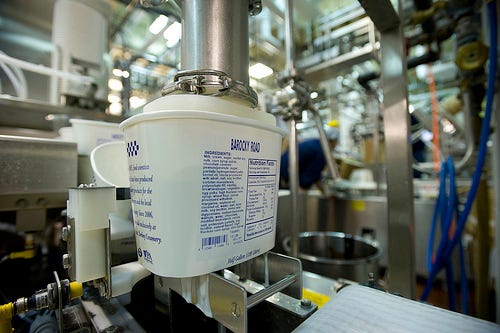Avoiding a plastic surprise: Preventing food product contamination
Penn State University made headlines once again. This time, it had nothing to do with the football program, but rather reports of the discovery of foreign objects in half-gallon ice cream containers sold at its campus creamery.A consumer reported in May that a penny was found in a half-gallon of ice cream purchased over the counter at the Berkey Creamery on the University Park campus, according to the university.
August 22, 2012
Penn State University made headlines once again. This time, it had nothing to do with the football program, but rather reports of the discovery of foreign objects in half-gallon ice cream containers sold at its campus creamery.
A consumer reported in May that a penny was found in a half-gallon of ice cream purchased over the counter at the Berkey Creamery on the University Park campus, according to the university.
 Both creamery officials and the university police believed it was an isolated occurrence. However, three more incidents have been reported involving pieces of plastic found by consumers in various flavors of ice cream purchased over the counter at the creamery, the university said. No injuries have been reported.
Both creamery officials and the university police believed it was an isolated occurrence. However, three more incidents have been reported involving pieces of plastic found by consumers in various flavors of ice cream purchased over the counter at the creamery, the university said. No injuries have been reported.
University officials have conducted an assessment of the process and manufacturing facility and determined that the plastic objects did not come from any of the manufacturing equipment in use and are not part of the production process.
From Kashi recalling 11,000 cases of its frozen pizzas because there could be pieces of plastic in the crusts to Heinz recalling thousands of pots of baby food because they could contain small pieces of plastic, there's been several accounts of fragments of plastics that entered the food during the production process.
Regardless of its size, any type of plastic contamination found in the finished product can become a public relations nightmare for both the brand and the food packager. After all, just a small piece of plastic contamination can result in a major recall along with potential lawsuits. The FDA considers hard objects, equal to or greater than .28" (7 mm) in length, to present a potential choking hazard.
Major restaurant chains and food processors are beginning to utilize plastic and rubber parts that are x-ray or metal detectable as a way to prevent food product contamination from reaching the consumer.
John Collins, Manager of Plastics and PolyMag Processing for Eriez, told PlasticsToday there seems to be an increased interest in these methods the past couple of years.
"Plenty of companies recognize the value of good brand names and they do not want anything damaging their reputation," he said. "When there is a problem with broken plastics, the damage to the brand image can be pretty expensive."
Eriez designs, develops, manufactures and markets magnetic separation, metal detection and materials feeding, screening, conveying and controlling equipment for process and metalworking industries.
One product that is gaining momentum for Eriez is its FDA compliant PolyMag additives that impart metal detectability, x-ray contrast, and magnetic susceptibility into plastic moldings to protect consumers from plastic contaminated food products.
Eriez supplies its masterbatch PolyMag additives to molders of returnable plastic containers, pallets, scoops, scrappers, o-rings, gaskets, conveyor belting, drive belting, bucket elevators and more.
The additives are typically included at 10-20% loadings in moldings and extrusions and the masterbatch pellets are available with various carrier resins.
"This is specifically for the plastics and rubber industry to avoid and detect a contaminated product for the consumers, which would have been nice for our friends over at Penn State," he said.
The Hazard Analysis and Critical Control Points (HACCP) is a management system in which food safety is addressed through the analysis and control of biological, chemical, and physical hazards from raw material production, procurement and handling, to manufacturing, distribution and consumption of the finished product.
The FDA and the United States Department of Agriculture (USDA) use mandatory juice, seafood, meat and poultry HACCP programs. However, the use of HACCP is currently voluntary in other food industries.
"The FDA pays a lot of attention to potential issues caused from E. coli and such but doesn't seem to apply the same level of scrutiny to broken pieces of plastic," Collins said. "A lot of places don't apply regulatory requirements but the bigger you get and the bigger the brand name, it's better idea to take all measures to make sure the product is clean."
About the Author(s)
You May Also Like


